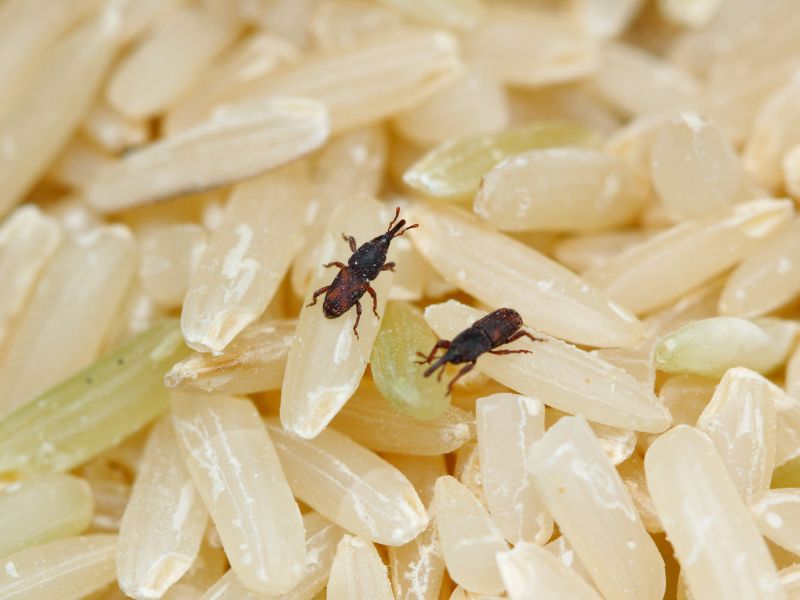Bed bugs are notorious pests that infest homes and cause sleepless nights, but many other bugs can be mistaken for them. Identifying the correct pest is critical for effective treatment. This article explores 16 bugs that resemble bed bugs, describing their characteristics and how to distinguish them.
1. Fungus Beetles

Description: Fungus beetles are small, elongated to egg-shaped insects usually found in damp areas where mold or fungus grows. They are brown or reddish-brown, which can make them look like bed bugs at a glance.
How to Distinguish:
- Fungus beetles have longer antennae than bed bugs.
- They are typically found near damp areas or mold, whereas bed bugs are found in sleeping areas.
2. Fleas

Description: Fleas are tiny, wingless insects that feed on the blood of mammals and birds. Their flattened bodies and reddish-brown color may cause confusion with bed bugs.
How to Distinguish:
- Fleas jump when disturbed; bed bugs cannot jump.
- Fleas are commonly found on pets and their bedding, while bed bugs are found in mattresses and furniture.
3. Psocids (Barklice)

Description: Psocids are soft-bodied, tiny insects often found in humid areas. They feed on mold and mildew, not blood.
How to Distinguish:
- Psocids are smaller and have translucent bodies.
- They do not bite or feed on blood.
4. Booklice

Description: Booklice are tiny insects found near paper, books, and stored grains. Their small size and pale color can lead to confusion with young bed bugs.
How to Distinguish:
- Booklice are lighter in color, usually pale white or gray.
- They do not bite or feed on humans.
5. Spider Beetles

Description: Spider beetles are small, round insects with a shiny body that can appear reddish-brown or black, similar to bed bugs.
How to Distinguish:
- Spider beetles have a distinct humpbacked appearance.
- They are often found in food storage areas, not beds.
6. Springtails

Description: Springtails are tiny insects with elongated bodies. They are often found in moist environments.
How to Distinguish:
- Springtails jump when disturbed, unlike bed bugs.
- They do not bite or feed on blood.
7. Ticks

Description: Ticks are blood-feeding arachnids that are flat and oval-shaped, making them resemble bed bugs in certain stages.
How to Distinguish:
- Ticks have eight legs, while bed bugs have six.
- Ticks are more commonly found outdoors or on animals.
8. Carpet Beetles

Description: Carpet beetles are small, oval-shaped insects with a patterned shell. Their larvae may also be mistaken for bed bugs.
How to Distinguish:
- Adult carpet beetles have patterned wings, unlike the smooth bodies of bed bugs.
- Larvae are hairy and worm-like.
9. Bat Bugs

Description: Bat bugs are very similar to bed bugs and feed on bat blood. They are found in areas where bats roost.
How to Distinguish:
- Bat bugs have longer fringe hairs on their thorax.
- They are typically found near bat nesting sites.
10. Swallow Bugs

Description: Swallow bugs closely resemble bed bugs but are associated with swallow birds’ nests.
How to Distinguish:
- Swallow bugs are found near bird nesting areas.
- They rarely infest human living spaces.
11. Head Lice

Description: Head lice are small, wingless insects that infest human hair. Their size and shape can resemble bed bugs.
How to Distinguish:
- Head lice are found in hair, not bedding or furniture.
- They are smaller and more elongated than bed bugs.
12. Baby Cockroaches

Description: Young cockroaches, especially those of the German species, are small and reddish-brown, resembling bed bugs.
How to Distinguish:
- Cockroaches have long antennae and a more cylindrical body.
- They are faster movers than bed bugs.
13. Oribatid Mites

Description: Oribatid mites are tiny, round insects often found in soil or organic matter.
How to Distinguish:
- They are found in outdoor environments, not in homes.
- Oribatid mites are smaller and do not bite humans.
14. Pill Bugs and Sow Bugs

Description: Pill bugs and sow bugs are crustaceans with segmented bodies that can roll into a ball.
How to Distinguish:
- They have a hard shell and multiple legs.
- They are found in damp, dark places, not in bedding.
15. Weevils

Description: Weevils are small beetles with elongated snouts. Their small size and color can cause confusion with bed bugs.
How to Distinguish:
- Weevils have a distinct snout.
- They are commonly found near grains and stored food.
16. Minute Pirate Bugs

Description: Minute pirate bugs are small, oval-shaped insects that can bite humans, causing irritation.
How to Distinguish:
- They are much smaller than bed bugs.
- They are predatory and found in gardens, not in bedding.
Conclusion
While many bugs can resemble bed bugs, careful observation can help distinguish them. Understanding their characteristics and habitats is key to proper identification and treatment. If you’re unsure about the pest in your home, consult a pest control professional for accurate identification and advice. If you are looking for reliable bed bug services, click here to get expert help.





Leave a Reply